2025.07.12
Katsuobushi: The Secret Behind Japan’s Incredible Flavors
By Chef Yuuki Tanaka, owner of Ise Sueyoshi — Tripadvisor Best of the Best: Japan #1, World #12.(source).
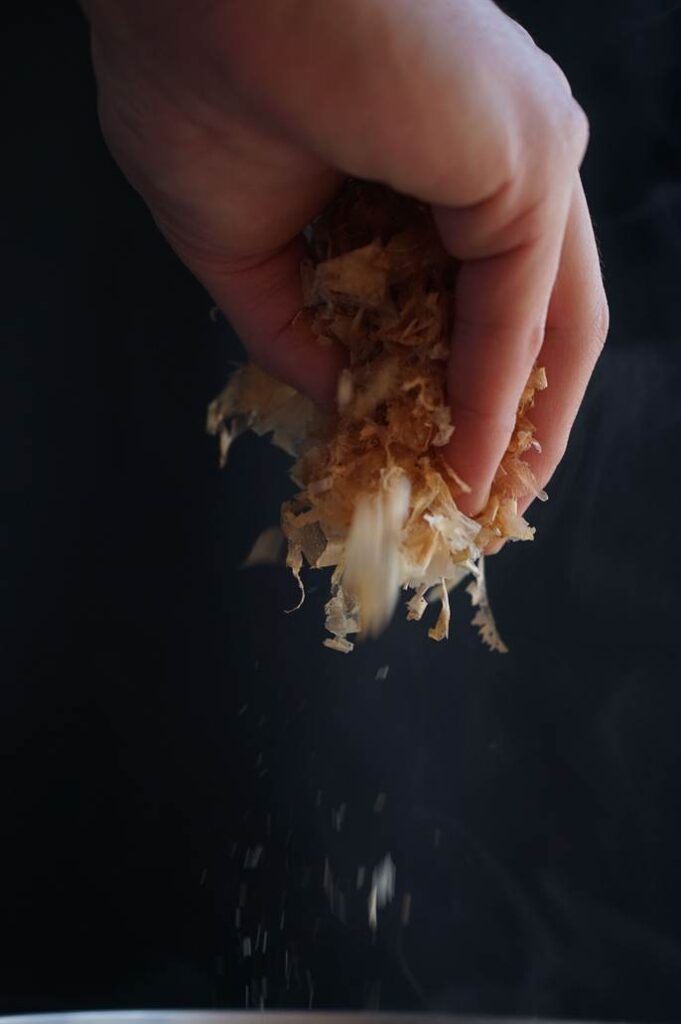
What You’ll Learn in This Article:
- What Katsuobushi is and how it’s made — from skipjack tuna to smoky flakes
- Why it’s considered the heart of Japanese umami
- How dashi (Japanese broth) is made using Katsuobushi
- Traditional and modern uses of Katsuobushi in Japanese cuisine
- How Ise Sueyoshi highlights this ingredient in its seasonal kaiseki courses
What Is Katsuobushi
The secret behind the exquisite taste of Japanese cuisine lies in Katsuobushi.
“Katsuobushi” is a traditional Japanese preserved food. While it is often translated as “dried bonito flakes” in English, such a simple description fails to capture its intricate production methods and rich cultural background. Made from skipjack tuna (also known as bonito), the fish is repeatedly smoked, dried, and aged using techniques unique to Japan.
There are different types of katsuobushi, including arabushi (lightly processed) and karebushi (fermented and mold-aged). Among them, honkarebushi—which undergoes multiple rounds of mold application—is one of the hardest food products in the world. It must be shaved to release its flavor and aroma, and is said to rival the hardness of quartz or topaz.
Katsuobushi forms the foundation of dashi, the essential broth in Japanese cuisine. Japanese food is known for its delicate, subtle flavors—not relying on oils, fats, or heavy spices. The richness comes from umami, a savory depth unique to this culinary tradition. Katsuobushi contains inosinic acid, which, when combined with glutamic acid from kelp, produces an unmatched complexity of taste.
Despite having nearly zero calories, katsuobushi offers a deeply satisfying flavor that nourishes both body and soul. This is the true power of katsuobushi.

Japan’s Signature Broth
Across the globe, every region has its own signature soup that reflects the essence of its culinary culture. In French cuisine, there is bouillon or fond; in Chinese cooking, shang tang (superior broth). These are typically characterized by long hours of simmering—extracting flavor from large amounts of bones, vegetables, and spices. Such soups are often made in large batches and stored for future use.
In contrast, Japan’s dashi takes a completely different approach. Its ingredients—such as kombu (kelp), katsuobushi (dried bonito), shiitake mushrooms, and niboshi (dried sardines)—are all pre-dried and aged over time, often for months. These ingredients can be stored at room temperature and are used to prepare fresh dashi quickly, in small amounts as needed. For example, katsuobushi can release a rich aroma and deep umami within just 10 seconds of simmering, resulting in a delicate yet full-flavored ichiban dashi (first broth).
What’s even more remarkable is that these ingredients are not made by chefs, but by dedicated artisans who specialize in their production. In the case of katsuobushi, it can take months of smoking, drying, and fermentation to create a single piece—elevating it to the level of a traditional craft.
In essence, Japan’s dashi culture is built on the philosophy of “investing time in the ingredients, while keeping the cooking simple.” It is both subtle and powerful, and deeply respectful of the natural beauty of each element. This refined approach is what sets Japanese dashi apart from other broths around the world.
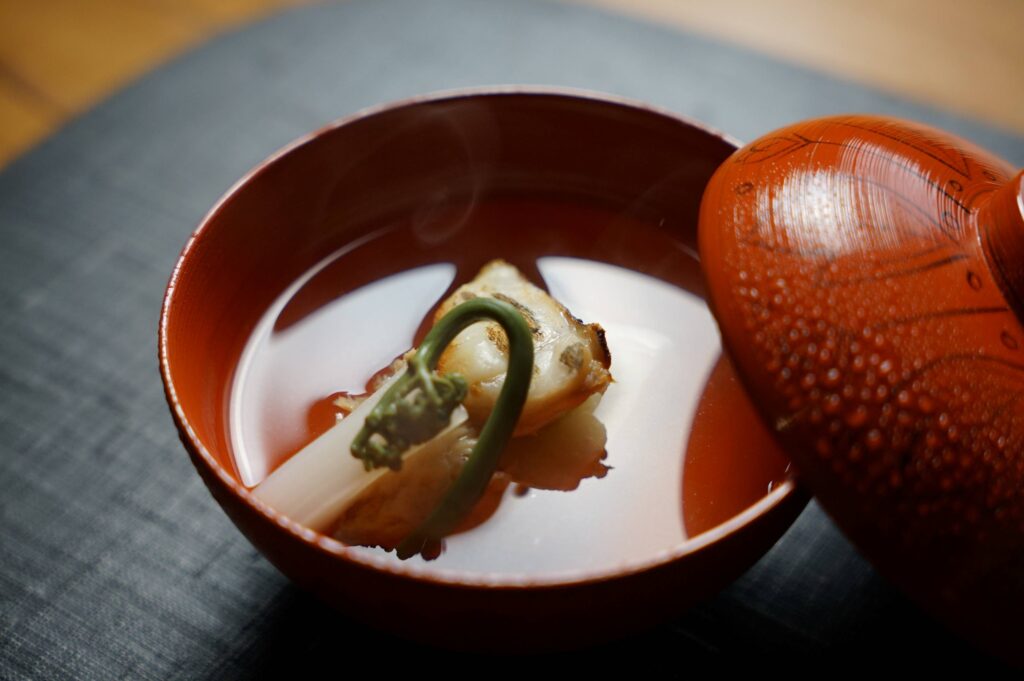
Crafted With Time
The true allure of katsuobushi lies not only in its flavor, but in the extraordinary time and care it takes to produce. The process begins by filleting skipjack tuna into thirds and simmering them to cook the meat. The fillets are then smoked repeatedly over firewood, slowly removing moisture while imparting a rich aroma. This smoking stage spans several weeks, repeated patiently until the desired texture is achieved—this is known as arabushi (rough-dried bonito).
From there, the surface of each fillet is shaved and refined, and then inoculated with a specific mold. This is followed by cycles of sun-drying and further mold cultivation, deepening both the fermentation and the dryness. This entire maturation process can take several months, and in many cases, more than half a year is needed to complete a single piece.
The highest grade, known as honkarebushi, is a true artisanal masterpiece—lovingly crafted by skilled hands. Its cross-section is remarkably beautiful, and its density is so intense that it feels as hard as metal when held. Within each piece lies the Japanese aesthetic of “savoring time” and a deep cultural reverence for fermentation.

Umami Meets Umami
The magic of umami is born from the meeting of two extraordinary ingredients.
One is kombu—a gift from the sea, cultivated along the coasts of Hokkaido. Naturally sun-dried and slowly aged over time, kombu becomes rich in glutamic acid, the essential compound responsible for umami. Particularly prized are kura-gakoi kombu, which have been aged in storage for over a year, developing a softer, rounder depth of flavor.
The other is katsuobushi, rich in inosinate. When combined with glutamate, it produces the famed “umami synergy effect.” The result is a depth of flavor that neither ingredient can achieve on its own—a clean, delicate, yet profound taste that defines Japanese cuisine.
At Ise Sueyoshi, we carefully craft both our first and second broths (ichiban dashi and niban dashi) to maximize this golden pairing and elevate each seasonal dish with refined harmony.

Ise Sueyoshi’s First Dashi (Ichiban Dashi) Recipe
Ingredients
- 15g kombu (preferably kura-gakoi aged kombu)
- 1L soft water
- 30g katsuobushi (freshly shaved honkarebushi)
Method
- Place 15g kombu and 1L water in a pot. Slowly heat to maintain 60°C (140°F) for 1 hour.
- Remove the kombu.
- Increase heat to bring to a boil, then turn off the heat.
- Once the temperature drops to around 90°C (194°F), add 30g of katsuobushi and gently submerge it.
- Let it steep for about 10 seconds, then strain carefully.
Recommended Uses
Perfect for delicate dishes where the broth plays the leading role, such as clear soups (osuimono), chawanmushi (savory egg custard), and traditional soup bowls.
When using as osuimono, season lightly with just a pinch of salt and a few drops of soy sauce.
Ise Sueyoshi’s Second Dashi (Niban Dashi) Recipe
Ingredients
- Used kombu and katsuobushi from first dashi
- 1.5L water
- Optional: 5g additional kombu
- Optional: 10g additional katsuobushi
Method
- Place the used kombu and katsuobushi from the first dashi into a pot. Add 1.5L water, and optionally more kombu or katsuobushi depending on your preference.
- Bring to a simmer over medium heat, skimming off any foam, and continue simmering for 10–15 minutes.
Adjust simmering time based on the dish’s intensity needs. - Use the finished second dashi for hearty dishes such as simmered foods, miso soup, or seasoned rice (takikomi gohan).
Tips
Second dashi has a deeper color and stronger flavor than first dashi, making it ideal for recipes where the broth plays a supporting—but still essential—role.

Crafting Katsuobushi
At Ise Sueyoshi, the foundation of our flavor lies in the hands of a remarkable producer: Kyuumasa, a katsuobushi maker located in Daio Town, Shima City, Mie Prefecture. Founded in 1897, this long-established company has preserved the techniques and spirit of traditional katsuobushi-making for over a century. Every single block of their katsuobushi carries with it time, devotion, and deep human intent.
Kyuumasa Katsuobushi 創業明治参拾年 伊勢志摩 鰹節製造 久政(きゅーまさ)公式サイト
I first met President Hashizume of Kyuumasa just before opening Ise Sueyoshi. His words, shaped by a life lived alongside the sea of Shima, conveyed sincerity and unwavering dedication to his craft. When I visited the workshop, I was moved by the sight of artisans standing in front of the fire with thick towels wrapped around their heads, quietly tending to the flames. These were not just workers—they were guardians of Japanese flavor, shaving each block with a sense of mission.
Kyuumasa is known for reviving an age-old technique called “tebiyama-shiki”, a traditional method of smoking and drying bonito over wood fires in large kilns. Unlike modern mechanical processes, this hands-on method produces flakes with a deep aroma and richness. Reading the temperature and humidity by feel, the artisans carefully adjust the fire—an intuitive skill developed only through years of experience.

Kyuumasa’s katsuobushi is distinguished by its elegant fragrance and clear, rounded umami. The moment you taste our first dashi made with their flakes, you’ll understand—it’s the kind of flavor that seeps into your very being. That soothing depth is made possible only through their craftsmanship.
Highly regarded for both professional and gift use, Kyuumasa’s katsuobushi is a true treasure. Whether as a memory of your journey or a way to bring authentic flavor into your own kitchen, we invite you to experience its aroma and depth firsthand. It is here, through the passion of dedicated artisans, that the true essence of Japanese flavor continues to live on.
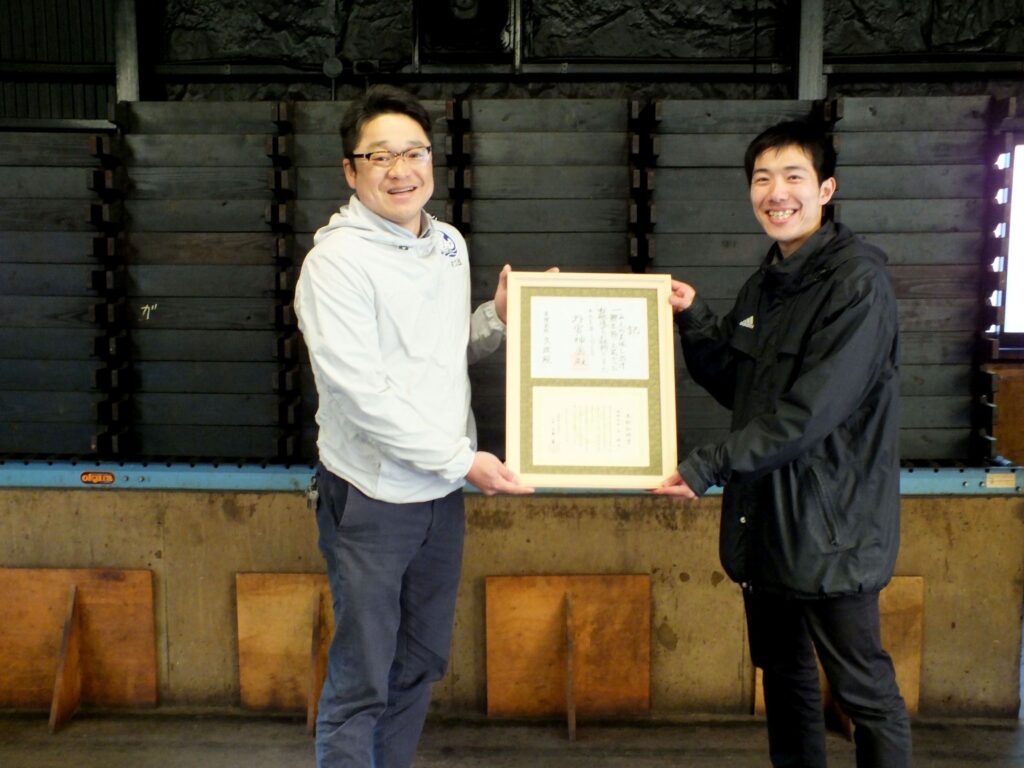
Water Shapes Flavor
In Japanese cuisine, dashi is more than just a foundation—it’s the very soul of flavor. And while ingredients like kombu and katsuobushi are essential, there’s another element just as vital to the quality of dashi: water.
Japan’s water is exceptionally soft—classified as soft water or even ultra-soft by global standards—and this unique characteristic plays a central role in the development of Japan’s delicate dashi culture. With abundant rainfall, short distances between mountains and sea, and steep rivers, rainwater in Japan passes through the land quickly, without absorbing much mineral content. As a result, the water remains low in calcium and magnesium, making it ideal for drawing out subtle umami flavors from ingredients like kombu and bonito flakes.
By contrast, many countries—particularly in Europe—rely on hard water, which contains higher mineral levels that can interfere with flavor extraction. For example, hard water makes it difficult to draw out kombu’s glutamic acid, often resulting in a less refined broth.
This difference in water composition is one of the biggest challenges when preparing authentic Japanese cuisine abroad. At Ise Sueyoshi, during a 2024 collaborative pop-up at the two-Michelin-starred restaurant TUJU in São Paulo, Brazil, we overcame this by installing a Cleansui water purification system, allowing us to reproduce the delicate nuances of Japanese dashi with great success.
In addition, we developed an educational program for high school culinary students in collaboration with Cleansui, where participants compared and tasted 14 types of dashi made with different water sources—reinforcing the essential relationship between water and umami.
“Water is as much an ingredient as kombu or katsuobushi.” Once you taste a bowl of carefully prepared dashi, you’ll understand that this is not an exaggeration—it’s a truth at the heart of Japanese culinary tradition.
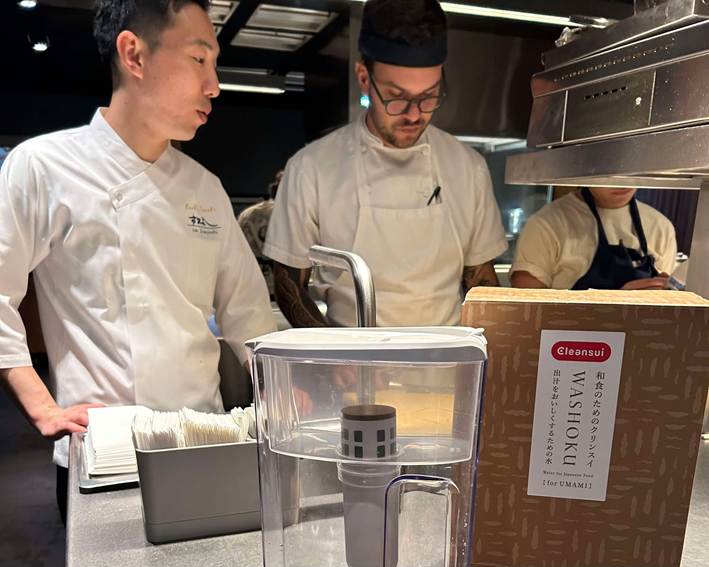
Vegetarian-Friendly Depth
At Ise Sueyoshi, we believe that even those who follow a vegan lifestyle should be able to fully experience the depth and beauty of Japan’s dashi culture. That belief led us to develop a plant-based version of traditional kaiseki, where every element is crafted without the use of animal products.
In Japanese cuisine, dashi forms the very backbone of flavor. In conventional kaiseki, the first broth—made with katsuobushi (bonito flakes)—is essential for creating depth and subtlety. Reproducing the same layered, elegant taste without animal ingredients, however, is no easy feat.
In the world of shojin ryori (traditional Buddhist cuisine), a broth made from kombu (kelp) and dried shiitake mushrooms has long been the standard. At Ise Sueyoshi, we went further—pushing the boundaries of plant-based umami. In addition to shiitake, we began incorporating dried enoki mushrooms, aiming to create a more layered flavor. Yet this raised another challenge: the risk of losing the clarity and refinement expected of kaiseki cuisine.
That’s when we discovered the transformative potential of gobo-cha (burdock tea) and Jerusalem artichoke tea, two caffeine-free infusions rooted in Japanese tradition. Though called “teas,” they contain no tea leaves—just the earthy aroma and soft sweetness of root vegetables. When subtly blended into kombu-based dashi, these ingredients brought surprising complexity and balance—without compromising the delicate essence of the cuisine.
The result is our signature vegan dashi, a broth that gently enhances each ingredient while unifying the entire course. It allows vegetarian and vegan guests visiting Japan to experience authentic kaiseki—crafted with the same care, precision, and storytelling as its traditional counterpart.
From this “plant-based ichiban dashi,” a new culinary narrative begins—one that welcomes all to the heart of Japanese cuisine.
For more about our vegan or vegetarian philosophy please visit this page.
Ise Sueyoshi’s Vegan Dashi Recipe
Ingredients
- 15g kombu (preferably aged kura-gakoi kombu)
- 1L soft water
- 15cc burdock tea (gobo-cha)
- 15cc Jerusalem artichoke tea
Method
- Roughly chop the burdock root and Jerusalem artichoke. Roast them in an oven at 130°C (266°F) for 30 minutes to create burdock and Jerusalem artichoke teas.
- In a pot, combine 15g of kombu and 1L of soft water. Slowly heat the water, maintaining a temperature of 60°C (140°F), for 1 hour.
- Remove the kombu from the pot.
- Raise the heat until the water reaches a boil, then turn off the heat.
- When the temperature drops to around 90°C (194°F), add 15cc of burdock tea and 15cc of Jerusalem artichoke tea. Let them steep gently.
- After about 60 seconds, strain the broth carefully.
Tip
This vegan dashi is delicately balanced to highlight the natural umami of plant-based ingredients while maintaining the elegance and clarity of traditional kaiseki.
Savoring Seasonal Broth
Ichiban dashi is a quiet force — a “silent assertion.” It does not proclaim itself boldly, yet within its gentle presence lies the profound depth and lingering resonance of Japanese cuisine. Its essence is to elevate each ingredient, bringing the contours of flavor into sharp relief.
In spring, pour dashi over tender young bamboo shoots, and you’ll taste the clear, awakening breath of the mountains.
In summer, wrap fresh winter melon in a delicate broth, and feel the cooling sensation seep into a sun-warmed body.
In autumn, the earthy aroma of wild mushrooms entwines with dashi, evoking the feeling of walking through a deep forest.
In winter, fluffy taro softens in the broth, offering the quiet warmth unique to the cold season.
Japan is a land of ever-changing shun—seasonal peaks of flavor. But what makes Japanese cuisine truly exceptional is its ability to capture the fleeting beauty of these short-lived ingredients using time-honored techniques of preservation and fermentation. Kombu, katsuobushi, dried shiitake mushrooms, miso, and soy sauce—all shelf-stable ingredients—enable chefs to magnify the brilliance of ingredients that appear only briefly each year, like blossoms in a passing season.
This delicate balance of “preservation” and “season” is brought to life through the skill of the chef—who reads nature’s rhythms and harmonizes them on the plate.
That is why Japanese cuisine remains an unparalleled culinary art in the world.
At Ise Sueyoshi, we follow the traditional structure of kaiseki, offering monthly menus that showcase the unique flavors of the season. With dashi as the quiet yet powerful supporting actor, each dish becomes a reflection of the time of year.
Welcome to a journey of seasonal sensations—where you can taste the fragrance of the moment with all five senses, through the art of kaiseki.
For more about “Shun” please visit this page.https://ise-sueyoshi.com/infomation-en/124-2/
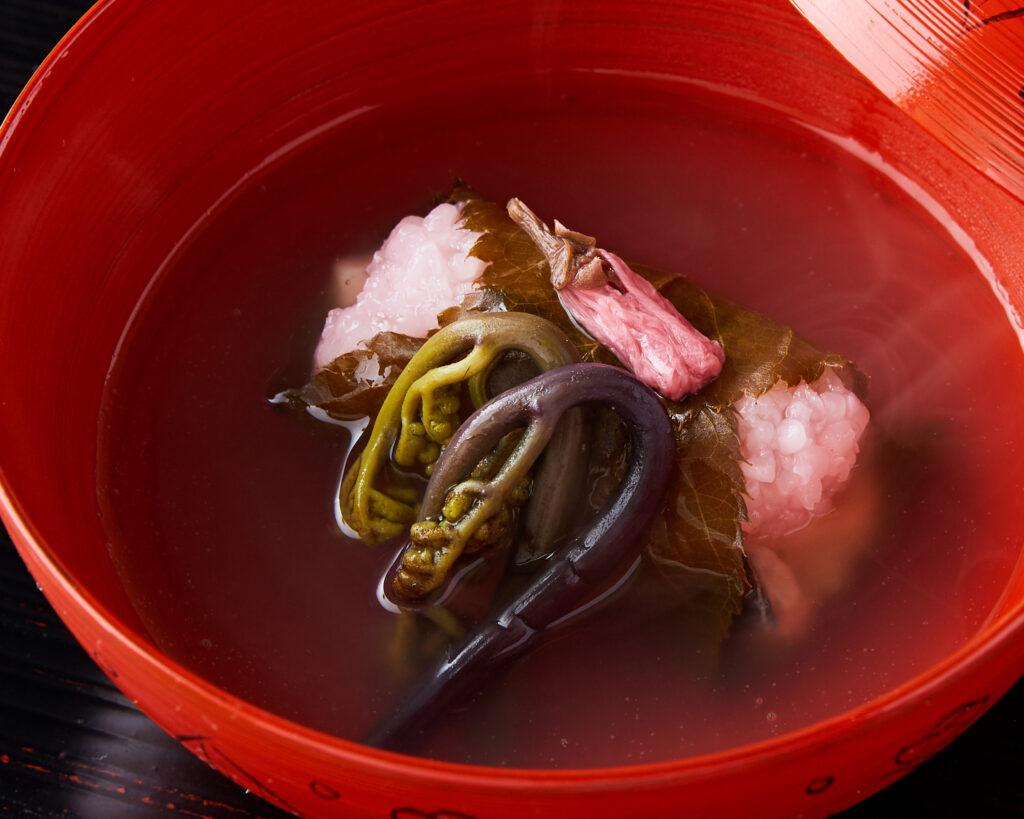
A Kaiseki Essential
Kaiseki is a uniquely Japanese culinary tradition—an art form that tells the story of the seasons through a series of carefully composed dishes. Rooted in the spirit of hospitality from the tea ceremony, it has evolved into a refined multi-course meal built upon the foundation of “one soup, three sides.” Each course is infused with seasonal awareness and a deep sense of care.
From the assorted seasonal appetizers known as hassun, to simmered dishes and delicate soup bowls, each plate features ingredients at their peak. And the key that elevates each flavor to its fullest expression is dashi. More than just a seasoning, dashi draws out the essence of each element, creating a harmony that appeals to all five senses.
Kaiseki also speaks to the sixth sense—it embraces the concepts of yohaku (negative space) and yoin (lingering resonance). The rising aroma, the temperature of the dishware, the interplay of light and shadow—every detail is part of the experience of being welcomed and honored.
At Ise Sueyoshi, we capture the subtle transitions of the seasons and weave them into a story, one dish at a time. Behind each creation breathes the silent protagonist: katsuobushi dashi, the soul of our cuisine.
Read more: What is Kaiseki cuisine?

Kaiseki Chef Yuuki
At Ise Sueyoshi, Head Chef Yuuki Tanaka sees cooking as a form of translation—one that conveys the life and intentions behind each ingredient. Behind every dish lies the silent presence of those who devote themselves to the land and sea. For Chef Yuuki, it is his calling to give voice to these producers through the language of food.
All of the ingredients used by Chef Yuuki—including katsuobushi—are sourced from his home prefecture of Mie. He maintains close, daily contact with farmers and fishermen, discussing everything from weather conditions to harvest timing and ingredient quality. “The people who know the true peak of a product’s season are the producers themselves,” he says. Guided by this trust, he travels regularly to ports and farms throughout Mie, including the dashi producers like Kyūmasa, where he personally checks the quality with his own eyes and palate.
At Ise Sueyoshi, we offer kaiseki courses that highlight Japan’s finest seasonal ingredients. The Ise lobster, with its firm texture and refined sweetness; the delicately poached abalone, rich in aroma and tender to the bite; the Iga wagyu beef, whose melt-in-your-mouth umami fills the senses. We also serve rare courses using wild-caught fugu and top-grade bluefin tuna from southern Mie—each dish carefully composed to express nature’s brilliance.
To share the stories behind these ingredients, we created a one-of-a-kind “Producers’ Almanac,” of which only three copies exist in the world. This special book introduces the people and places behind each dish, including a section dedicated to dashi that delves into the regions, techniques, and flavor profiles of kombu and katsuobushi.
What Chef Yuuki calls the “Circulation of Heart” is a cycle of care and gratitude: respecting the life of every ingredient, passing the producers’ heartfelt dedication to the guest, and returning the guest’s appreciation back to the hands that nurtured it. For those who seek to experience authentic dashi in Tokyo, Ise Sueyoshi offers not just a meal, but a deeply human story—woven with flavor and soul by Chef Yuuki himself.
Read More about fugu (pufferfish)
Read More about Ise Ebi Lobster

Our Guest’s Voice
The Best Meal I’ve Ever Had, and It Wasn’t Close
Jun 2023
Simply unbelievable meal. The only thing that I’ll preface the praise with is that finding this place is a bit challenging. It’s on the fourth floor and almost unmarked. Google Maps got us there. It is not a “restaurant” as you walk in and there’s a bar for you to sit at, behind which Chef Yuuki and his team will prepare the food. Very cozy. I had a little knowledge of Kaiseke meal preparation and service but Chef Yuuki blew me away. His technique and skill are superlative. Most notably for me is his command of salt: it was used in the dishes in such a precise and effective way that you would never think of adding more and allows the other flavors to flourish. The clams and dashi soup were a foot better than anything I’ve ever tried. I cook a little, and I have no earthly idea how he infused that much flavor into the wagyu beef peppercorns. But come for the food and stay for the lovely conversation. Chef Yuuki speaks English well and has a book that he flips open to each dish, allowing you to get an idea of where he’s from (Ise) and the community that harvests this wonderful food. In short, this is a very expensive meal ($640 for four people). I almost didn’t book it because the age limit is “high school” and my kids are only 14, but they loved it too. Yuuki expertly worked around a beef and pork allergy, which, I promise you, is difficult to find in Tokyo. Do this. You will not regret it.
We are proud to continue delivering an exceptional dining experience that earned us the Tripadvisor Travelers’ Choice Best of the Best 2024 award, ranking among the Best Restaurants in Tokyo. Our commitment to excellence in service and our dedication to offering the finest kaiseki dining experience in Tokyo remain unwavering. Discover more about our journey to becoming one of the best restaurants in the city[here].

Visit Ise Sueyoshi
Location: Conveniently located 12 minutes from Roppongi Station and 8 minutes from Hiroo Station.
Hours: Open 5:00 PM – 10:00 PM, reservations only. Closed on Sundays and Mondays.
Book Your Experience ☟
Reservation Information
In response to many requests from our guests, Ise Sueyoshi now accepts reservations up to 180 days in advance of your preferred dining date.
With only 10 seats available, we are committed to providing a smooth and personalized reservation experience.
To ensure you don’t miss the opportunity to celebrate your important anniversaries or special occasions with us, we highly recommend making your reservation as soon as your plans are set.
If you are planning a trip to Japan, we warmly invite you to include a special moment at Ise Sueyoshi in your itinerary.
Many of our guests also choose us for their final evening in Japan, as a beautiful and memorable way to conclude their journey.
Please note that our reservation policies may change without prior notice. For the latest updates, please refer to our reservation page.
Conclusion
At Ise Sueyoshi, we humbly invite you to experience a dining journey that caters to all dietary needs. Whether you’re vegan, halal, or have specific preferences, we are here to create a memorable and inclusive dining experience for you, especially for special occasions like a honeymoon.
Recommended Blog Posts
On our blog, we offer further insights into Tokyo’s rich food culture and the unique culinary experiences we provide at Ise Sueyoshi. Be sure to check out these recommended posts:
Where Fireworks Meet Tokyo Kaiseki: A Summer Night of Elegance |
Why You Must Try Kaiseki Cuisine in Tokyo: A Unique Experience of Culinary Art and Intellectual Delight |
@isesueyoshi
o 🏆 Awarded the prestigious Best Luxury Restaurant by TripAdvisor
o 🌍 Ranked 2nd worldwide, 1st in Japan, and 1st in Asia
o ⭐ Google rating of 4.9 (as of 2024)
o ✅ Vegan-friendly
o ✅ Halal selections
o ✅ Gluten-free options
o ✅ Vegetarian delights
o ✅ Pork-free choices
o ✅ Perfect for pescatarians
o 🌈 Welcoming and inclusive environment for LGBTQ guests
o 🚃 Just a 12-minute walk from Roppongi Station or 8-minutes from Hiroo Station
o ⏰ 5:00 PM – 10:00 PM (reservations-only)
o 📅 Closed on Sun and Mon
